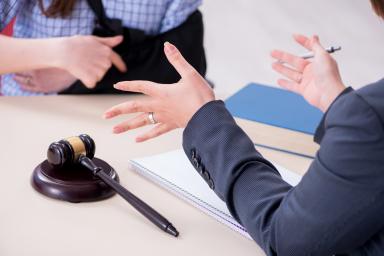Determining and Proving Liability in Slip-and-Fall Lawsuits

Each year, millions of Americans are impacted by slip-and-fall injuries. According to the CDC (Centers for Disease Control and Prevention), in 2023, personal injury cases ranked 4th among America’s causes of death or harm. You may be entitled to compensation, depending on the facts and circumstances of your case and the legal standards that apply. If you or a loved one has endured a slip-and-fall accident due to unsafe circumstances, you should contact a qualified lawyer immediately to find out your rights and how much compensation they could receive for your injuries.
However, to recover any damages owed, you must prove that another person or entity is at fault for your injuries.
How Your Slip-and-Fall Attorney Proves Liability
Slip-and-fall cases can be tricky to resolve as they can be hard to prove.
Liability could be assigned to the responsible party that knew or should have known about the hazardous conditions and should have addressed those conditions before the injury occurred.
While property owners cannot always be expected to immediately remove every risk or clean every unsafe surface on the ground, they still must provide a defined duty of care to individuals.
Use Negligence to Prove Fault
Negligence is the failure to behave with the level of care that a reasonable person would have exercised in the same circumstances.
Negligence in a slip-and-fall case refers to proving that a property owner's failure to act resulted in your injury or injuries. For a personal injury attorney to prove negligence, they are required to:
Prove the owner of the injury site owed you a duty of care (referring to a property owner's legal obligation to keep their site free of dangerous conditions).
Prove that the defendant (owner of the property) breached this duty.
Confirm that the defendant's actions or inactions caused your injuries.
Confirm that you were harmed as a direct result.
It is crucial to prove that the property owner's lack of care caused an injury as a result of hazardous conditions on the property and that the owner breached their duty of care by not addressing those conditions.
Other Ways to Prove Fault and Liability in Court
Aside from proving duty of care, there are other ways that personal injury attorneys can prove fault and liability. The following list provides additional resources for your attorney to strengthen your case:
Investigative Evidence
Evidence such as eyewitness statements, police or private investigation findings, and export reports are records that could help prove negligence in your case. These types of reports provide information that could be useful in identifying and solidifying faults in your slip and fall case.
Medical Records
After your injury, it is essential to immediately seek treatment for your health and safety and ensure that your injuries are treated by professionals and documented. You can request copies of your medical records from your medical provider to give to your attorney.
What’s the Difference Between Negligence, Strict, and Intentional Tort Liability?
A 'tort' is a civil wrong in which a solution may be obtained, typically in monetary compensation for injuries or damages. The major types of torts are intentional, negligence, and strict liability. The following information will help you understand which kind of claim may be appropriate for your situation.
Negligence Torts or Liability
Negligence differs from intentional liability in that the resulting injury or harm was not intentional. Negligence happens as a result of recklessness, distraction, or failure to act as defined by applicable law. The defendant was not acting purposefully but failed to act in a responsible manner in which a person of sane mind would. In order to successfully argue a negligence case, the plaintiff must demonstrate the following:
The party must owe a duty or service to the injured party.
The party who owes a duty or service must breach their obligation.
An injury must exist as a result of the defendant’s actions or inaction.
The injury cause must be reasonably expected due to the responsible party's negligence.
Intentional Tort Liability
When liability exists without proving negligence, an attorney may use Intentional torts. Intentional torts refer to deliberate actions that cause harm or damage and are usually defined by a statute or ordinance. The person responsible purposefully committed harm against an individual. Both intentional torts and negligent torts imply some fault on the part of the property owner or overseer.
Strict Liability
Strict liability torts also exist without proving negligence because they do not rely on the degree of care the defendant utilized. They are actionable simply by the fact that they occurred, usually by operation of law.
There are times when an act causing harm is neither intentional nor negligent. Still, a person or company could be held liable for your injuries. In strict liability cases, decisions rest on whether a particular harm or result materialized. Thus, a defendant must pay for the victim's losses even if the defendant was not careless and did not intend to harm.
Common Defenses in a Slip-and-Fall Case
State laws may impact the type of defense that is available to the defendant's attorney, as well as the case itself. Some defenses may be available only under specific circumstances, and it may be in your best interest to consult with your attorney to determine what defenses you can raise under your state's slip-and-fall laws if you find yourself as a defendant in a slip-and-fall case.
The defendant may not be liable if they have not had adequate time to fix or address a dangerous condition; if the condition is a naturally occurring condition; or, if they are not the absolute owner of the property. If the defense can prove that you caused your injuries by your carelessness, winning a slip-and-fall claim becomes highly unlikely.
Open and obvious
In this case, a defendant argues that a reasonable and sound person would have seen the hazard and, therefore, risk and would have taken steps to avoid the danger. However, this can pose potential problems because it is unclear what actions a "reasonable" person would take. Therefore, qualified lawyers refer to the applicable law as well as a company or property's standards. Additionally, a bit of common sense can be used to determine what is considered reasonable and what actions a "reasonable" person would take.
Comparative Negligence
Comparative negligence is a tort principle used by the court to reduce the amount of damages that a plaintiff can recover in a negligence-based claim according to the degree of negligence each party contributed to the incident. Specifically, when an injured victim was partially at fault because of their own negligence, the court may assign a percentage of fault to both the injured victim and the defendant.
This defense argues that the plaintiff was at fault (partially or entirely) for the accident or injury. For example, if the hazard was apparent and in the open, but the plaintiff was distracted, they failed to notice it. This distraction might result in a finding that they were at fault for the accident to a certain degree. The victim's award could then be reduced by the percentage of responsibility associated with their actions (or inaction). For example, the defense may ask if the plaintiff had lawful access to where the slip-and-fall accident occurred or if there was a legitimate reason for the plaintiff to be in a hazardous area.
Inadequate Notice
With this defense, the defendant argues that they did not have enough knowledge of the risk located on the property to know that the hazard existed. This defense can be effective if it is unclear where the risk arose or if the injured party needs more evidence to prove the existence of the threat.
Procedural Defenses
In this case, the injured party has identified the wrong party as the defendant. Different people or businesses may have been responsible for maintaining other parts of the property. Thus, the owner may not be the sole party in control of the premises. Suppose the injured party sues the wrong defendant. In that case, you can withdraw the complaint and refile if the statute of limitations has expired.
Resources for Injured Folks
Most folks first seek proper medical treatment to ensure legitimate documentation of their injuries after falling. After treatment, you must file a claim with your insurance provider. A claim is a negotiation with an insurance company to cover all or part of an accident, usually because another party is responsible. Claims are typically made outside of a court, and various people can be involved. If you need help filing a claim, please refer to Expertise.com's directory to speak to a slip-and-fall attorney.
However, you must file a lawsuit if you cannot resolve your claim with the property owner's insurance. Keep in mind that litigation can be time-consuming, expensive, and stressful. Consult a slip-and-fall attorney to know the path best for you and your situation.
1. How to Write an Accident Report
It is important to present your personal injury attorney with all the information regarding your slip-and-fall injury. The Occupational Safety and Health Administration (OSHA) requires that all businesses have proper incident reports available for you to fill out. However, if this is unavailable or you’d like someone to review the report, you can create your own or have one drafted by an attorney.
In your report, make sure you include all of the relevant details about your accident:
The date and time that you fell.
Where did you fall on the property?
What obstruction or hazard caused your fall,
Any witnesses to your fall.
Any pain you are experiencing or expect to experience.
2. Evidence You Should You Provide to Your Attorney
Collect any evidence from the medical professional who examined and documented your injuries. It is important to provide any photos of the property, as well as of the nature of your injuries. Witness testimony can also be used as evidence of the dangerous condition present on the property.
3. What to Include in Your Demand Letter
A demand letter is a written statement you give your insurance company to negotiate a settlement for your slip and fall injury. This letter documents the details of the accident, your injuries, income losses from medical treatments, and the total sum you are demanding as restitution. It is advisable to have a personal injury attorney review or help construct your demand letter to ensure that you are adequately compensated. For more information on how to write a demand letter, please refer to Expertise.com’s personal injury directory.
Some additional information may include the following:
Reasons for the other party’s fault.
Environmental conditions and circumstances of the property.
Type of treatment you received for your injuries.
Any other additional losses.
Expertise.com StaffAuthor
Step into the world of Expertise.com, your go-to hub for credible insights. We don't take accuracy lightly around here. Our squad of expert reviewers, each a maestro in their field, has given the green light to every single article you'll find. From rigorous fact-checking to meticulous evaluations of service providers, we've got it all covered. So feel free to dive in and explore. The information you'll uncover has been stamped with the seal of approval by our top-notch experts.

Ira PiltzReviewer
With over a dozen years of experience, Attorney Ira Piltz represents a broad spectrum of U.S. and foreign clients on a wide range of complex legal matters. Ira is widely sought for his expertise in all forms of real estate transactions, estate planning, and civil litigation. Visit: https://piltzlaw.com/

![How Much Does a Slip-and-Fall Lawyer Cost? [2023] DUP IMAGE](https://images.ctfassets.net/k00sbju4hbzq/6VjmgolPspyVjYLOfVY4wl/a1f9b84358d5e0069656c41ac3e63e96/Depositphotos_260604210_XL.jpg?fit=fill&w=384&q=75)


